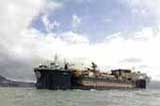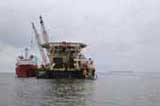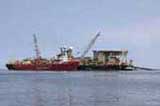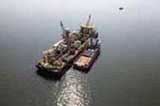
Pipe Laying Vessel - Castoro Dieci
Pipe laying of the 1,224 kilometre long Nord Stream Pipeline started in April 2010. Three pipe-laying barges were commissioned to work on the project..
- Saipem's Castoro Sei - for the majority of the route in the Baltic Sea
- Saipem's Castoro Dieci - for the shallow waters in Germany
- Allseas Solitaire - for pipe laying in the Gulf of Finland
Castoro Dieci Trench and Pipelay barge
The Castoro 10 is a working ship of the greatest Italian offshore service provider Saipem, a former subsidiary of the energy company Eni. Built in the Dutch shipyard Nederlandse Scheepsbouw 1976, it continues today under the flag of the Bahamas and is used as pipeline laying ship.
Trenching
Castoro 10 has equipment, to dig a trench into which the pipeline is laid. With the "Diverless Jet Sled 1" can thereby trenches with a grave depth of 4.3 m, are generated in a water depth of up to 300 m. The Castoro Dieci is able to work in shallow and coastal waters, because it has less draught, which is the vertical distance measured from the lowest point of a ship's hull to the water surface. With no means of self propulsion, the vessel relies on towing and anchor winching for the travelling and manoeuvring. Its 8-point mooring system enables it to maintain accurate positioning during pipelaying.
Pipe laying
The ship uses the S-lay method, to lay pipelines to a diameter of 60 inches. The two "Tensioner" thereby allowing a pulling force of 60 t. The processing of pipelines is provided by two stations, for chamfering the pipeline ends, a welding station and two stations for radiographic examination. At the end of the pipeline is still running the stations for surface coating.
Images Saipem's Castoro Dieci
General characteristics Castoro Dieci
Dimensions..
- Length - 139.1 m
- Beam - 36.6 m
- Depth - 9.1 m
Pipelay equipment..
- Fully enclosed production line for a 60" max. pipe diameter
- 2 Remacut tensioners, 90 t each (max. tension - 180 t in total)
- 1 Remacut abandonment and recovery winch, 200 t.
Trenching/jetting equipment..
- Length - 11.8 m
- Width - 12 m
- Height - 8.5 m
- Weight - 110 t
- Max. pipe diameter - 60"
- Max. trench depth - 4.3 m
- Max. operating depth - 300 m
- Jet pumps - 8 Union MQF 9 stage
- Output - 2,000 gpm x 2,500 psi
Mooring system..
- Anchors - 9 x 7 t Delta Flipper
- Winches - 8 Intercon 74-170, 50 t each
- Wire capacity - 180
Lifting equipment..
- Type - 2 Manitowoc 999 W and 4100W, max. capacity 72 t and 66 t
- Aft STBD crane Palfinger PTM 1700A 15 t
- 6 pipe davits, max. capacity 100 t each
- Accommodation capacity - 200 people
Reference(s) for the images and text, is owned by Nord Stream AG Saipem
Pipe laying Methods
The most common installation methods are the S-Lay, J-Lay, and Reel-Lay methods.
In the S-Lay method, as the laying barge moves forward, the pipe is eased off the stern, curving downward through the water until it reaches the touchdown point. After touchdown, as more pipe is played out, it assumes the "S" shaped curve. To reduce bending stress in the pipe, a stinger is used to support the pipe as it leaves the barge. To avoid buckling of the pipe, a tensioner must be used to provide appropriate tensile load to the pipeline (Clauss,1998). This method is used for pipeline installations in a range of water depths from shallow to deep.
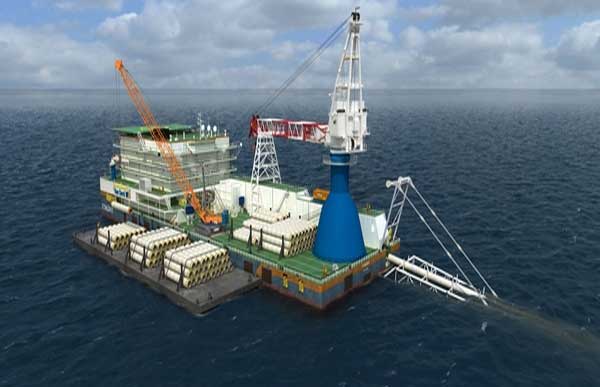 van Oord's Stingray uses the S-Lay method
van Oord's Stingray uses the S-Lay method
In the J-lay method, the pipe is dropped down almost vertically until it reaches touchdown; after that it assumes the "J" shaped curve. J-Lay barges have a tall tower on the stern to weld and slip prewelded pipe sections. With the simpler pipeline shape, the J-Lay method avoids some of the difficulties of S-Laying such as tensile load forward thrust, and can be used in deeper waters.
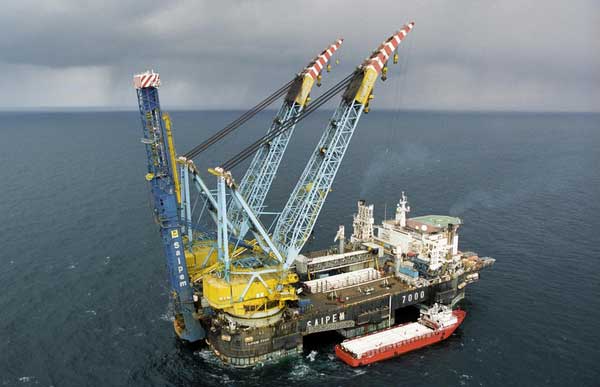 Saipem's 7000 barge uses the J-Lay method
Saipem's 7000 barge uses the J-Lay method
In the Reel-Lay method, the pipeline is installed from a huge reel mounted on an offshore vessel. Pipelines are assembled at an onshore spool-base facility and spooled onto a reel which is mounted on the deck of a pipelay barge. Horizontal reels lay pipe with an S-Lay configuration. Vertical reels most commonly do J-Lay, but can also S-Lay.
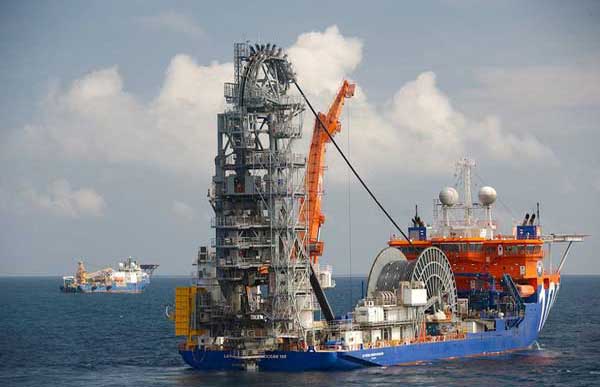 McDermott's North Ocean 105 uses the Reel-Lay method
McDermott's North Ocean 105 uses the Reel-Lay method